Rich and Poor
The Poor
In 1839 Joseph Gribble, coroner, presided over an inquest held at the Crispin Inn, Ashburton. Rumour had it that 73 year old William French had died of starvation, rather than go to a Union house. An autopsy was performed, where it was discovered that Mr French had an abscess on the brain. In their verdict, however, the jury refused to return this as the only cause of death, maintaining that his condition had been 'accelerated by the want of food'.
North Devon Journal 3 January 1839 p3 col2
*******
In 1849 Ashburton and Buckfastleigh argued about where George Blackler, a pauper, and his wife Mary were 'settled' - in other words, which parish should maintain them if they were in need. Solicitor Mr Tucker argued that they had not fulfilled the requirements to claim settlement, and it was ordered that they were the responsibility of Buckfastleigh.
Western Times 30 June 1849 p6 col3
Christmas 1849. R. Tucker distributed a large number of blankets amongst the poor.
Western Times 29 December 1849 p6 col1
*******
Charities
According to Charles Worthy, the following charitable gifts were made in Ashburton. Additional information referenced individually.
Ashburton and its neighbourhood, L B Varder, printer and publisher 1875, p 37, appendix pp vi-xi
Gift of Lawrence Blundell - an annuity of £4 yearly to educate and maintain a poor scholar of the parish at the School of Ashburton (ie the Grammar School).
In 1848 this was awarded to J Smerdon, orphan child of the butcher John Cockey Smerdon.
Western Times 30 December 1848 p7 col3
Hayman's Gift
Gifts of Page and Feymouth
Phipps' Gift
Caunter's Gift
Bovey's Gift
Prideaux's Gift
Sir John Acland's Gift
Knowling's Gift
Bounde's Gift
Ford's Gift
Stawell's Gift
A large number of shirt cloths were distributed to labourers by the trustees of both this and the Adams' bequest (see below)
Exeter Flying Post 28 December 1843 p3 col6
Edward Gould's Gift
School founded by Lord Middleton and the Hon John Harris (the Bourne School)
Bickham's Gift
In 1922 some properties connected with different charities were sold, and the funds re-invested in consolidated stock to provide an increased income.
The income for Bickham's Gift, used to provide bread twice weekly at the parish church increased from £24 to £54 per annum.
Western Times 5 May 1922 p9 col1
Harris' Gift
'Richard Harris, late of Ashburton, by will dated 3rd July 1778....charged a messuage, tenement and lands called Vickeridge, situate in the parish of Woodland, with the payment of the yearly sum of 11l 7s 6d to be disposed of in the manner following:viz. the sum of 10l for the use of 50 poor people....1l 1s to the vicar or curate...and to the clerk 2s 6d...and to each of the two sextons 2s...'
Report of the Commissioners concerning charities vol 1 and 2, p150-151
Gift of Sally Adams
Dunning's Gift
Donkin's Gift
Dean Ireland's Gift
Paid £5 each to 'six poor decayed tradespeople'
Exeter Flying Post 28 December 1843 p3 col6
Gifford's Gift
This bequest was made by William Gifford, whose will was proved in 1827
1842 was the 15th Christmas distribution. 10 men and 10 women were given 50s each, and 200 shilling loaves were distributed.
Western Times 31 December 1842 p3 col4
In 1848 a dispute arose around the distribution of this bequest - it was alleged that the vicar, the Rev W Marsh, had refused an application by James Easterbrook because of Mr Easterbrook's religious opinions. Letters were sent to the Western Times - on the 12th February Mr Solomon Tozer, writing in his capacity as Treasurer, utterly refuted suggestions that anyone had ever been rejected for this reason
Western Times 12 February 1848 p5 col3
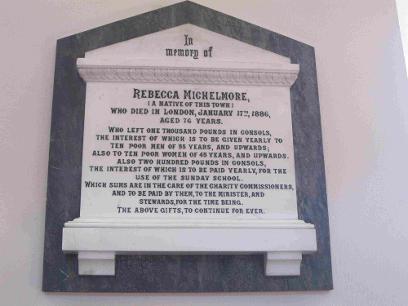
Left: A memorial in the Methodist Chapel to Rebecca Michelmore, who died in January 1886. She left £1000 in Consols, the interest to be given each year to ten poor men aged 55 and over, and ten poor women aged 45 and over. In addition the interest on £200 in Consols was to go to the Sunday School.
My own photograph 2015
Tozer's Gift
'A common sight (in the 1920s) was of elderly women emerging from church with loaves of bread, a custom discontinued in the days of the Welfare State'
Thanks to Hazel Bray for the quote above.
John Satterly remembers this - also that rolls of white calico were distributed at the Church gates on Christmas morning.
Memories of Ashburton in Late Victorian Days, John Satterly, Transactions of the Devonshire Association 1952 vol 84 p51
The Workhouse
On October 8th 1810 'A stranger from the workhouse' was buried.
Parish records
In 1827 Thomas Cane died of a paralytic seizure. He was Governor of the Workhouse
Western Times 20 October 1827 p1 col5
*******
In a transcript of burials between 1813 and 1837, nineteen are marked 'Of the workhouse', the last being Margery Guswill in January 1832. Vicars were not always consistent in their notes - and different vicars chose to note different things in the registers.
*******
1830 The Churchwardens and Overseers of Ashburton advertised for tenders to supply the Workhouse with the following: meat, drink, washing, fuel, candles, soap and groceries.
Exeter and Plymouth Gazette 15 May 1830 p1 col5
*******
Ashburton workhouse seems to have been operational until at least 1836 - the buildings at the Western end of the town were taken down in 1849 (see below). In contrast, Newton Abbot Workhouse was still going in 1905 (see the story of Albert Lion, in the 1800s section of Banks and Businesses).
Ashburton Burials 1813 - 1837 Devon Family History Society 1997
According to an article in the Western Morning News, (written a century after the event) the Newton Abbot Union began in 1836, as a result of the Poor Law Amendment Act 1834, and was the largest in the South West with the exception of Plymouth. Comprising 6 towns, including Ashburton, and 27 parishes, its claim to fame was that its treatment of its paupers led to a Local Government Board Inquiry in 1894.
Western Morning News 26 November 1929 p11 col2
*******
In 1836 J Alsop, Clerk to the Newton Abbot Union Office, sought tenders for the supply of foodstuffs for the paupers of various parishes within the Union, and for the workhouses of Ashburton and Chudleigh.
The items required included best seconds flour, best store dip candles, good black tea and good mealy potatoes.
Western Times 10 December 1836 p1 col3
In 1838 Mr. and Mrs. Hill, master and matron of the old workhouse at Ashburton, were chosen as schoolmaster and schoolmistress of the new workhouse at Newton Abbot.
Western Times 8 December 1838 p3 col6
1847. Mr T Hext won a three month contract with the Newton Abbot Union to supply bread to Ashburton parish, at 9¾d per 4lb loaf.
Western Times 19 June 1847 p7 col5
The next year Isaac Lamason won the contract for the same quarter. His tender was 4½d per 4lb loaf.
Western Times 17 June 1848 p7 col5
A report in 1849 stated that buildings had been sold and were being taken down at the Western end of the town. Formerly used as a workhouse, they were believed to have been built in Elizabethan times.
Western Times 24 November 1849 p7 col3
The Ashburton Tithe Map of 1840 shows two plots of land either side of what is now Western Road. Plot 1642 is called Alms House Field, and is roughly where Waverly House is now; plot 1702 is called Alms House Orchard and is roughly where Meadow View is now.
http://files.devon.gov.uk/tithe/tithemapsapp/ashburton.pdf
(list only, not the map itself)
Philip Spargo was summoned by the Overseers of Ashburton for failing to maintain his wife. She had left him 15 months ago, when he was very ill, and 12 months after that had given birth at the Newton Abbot Union. The case was dismissed.
Exeter and Plymouth Gazette 31 March 1849 p7 col6
1849. Stephen Yolland won a three month contract to supply bread to Ashburton parish, at 4½d per 4lb loaf.
Western Times 16 June 1848 p6 col4
A report in 1849 stated that buildings had been sold and were being taken down at the Western end of the town. Formerly used as a workhouse, they were believed to have been built in Elizabethan times.
Western Times 24 November 1849 p7 col3
By this time families applying for relief were usually given a piece of bread, and were sent to the Old Guard House, believed to be No 2 and 3 Bowden Hill (see Prisoners of War in Dartmoor towns, Trevor James, Orchard Publications, 2000, p14) Up to twenty men, women and children huddled on straw on the floor - there was no fireplace or chimney. No town, said the Western Times, needed a new lock-up more than Ashburton.
Western Times 24 February 1849 p6 col3
In 1853 dwelling houses, outbuildings and gardens in Plymouth Road were up for auction, together with a plot of ground, then occupied by Mr Thomas Hext, that was the site of the old workhouse. In addition the Alms House Orchard was also for sale, occupied by Thomas Hext jnr. All these sites, described as productive and beautifully situated, were connected.
Western Times 13 August 1853 p1 col3
*******
Christmas 1850. John Bunclark, aged 70, a resident in the Totnes Union Workhouse, asked for leave to go and visit his father, aged 95, in Ashburton. This was to return the visit his father had made the previous Christmas, when he had walked from Ashburton to Totnes to see his son.
Exeter and Plymouth Gazette 28 December 1850 p4 col2
In 1852 an inquest was held at the Town Arms, conducted by W A Cockey. Sarah Furneaux, aged 75, had been found dead at her two roomed cottage in Back Lane. Her bedding was described by the Western Times as consisting of an old flock mattress, with no covers other than rags and a borrowed patchwork. Recently taken ill, she had been seen by the relieving officer, and had been ordered to get ready to go into the Union House - on his arrival the next day, however, she said she was too ill to move, and begged to be allowed to stay another week. John Hele, the parish medical officer, had attended her twice.
Sarah had to live on a small loaf of bread
plus 2s a week - out of this she had to pay her rent. The inhabitants of
Ashburton were critical of the authorities, who should, they believed,
have provided proper food and bedding, 'seeing, as they did, the
pitiable state the poor creature lay in'.
*******
The jury took four hours to reach their verdict, which was that 'the deceased died from want of proper necessaries and attendance'. They appended a statement to their verdict expressing the view that Sarah would not have died in such 'miserable circumstances' had all those who attended her acted in a proper manner.
Western Times 20 March 1852 p7 col3
1854 James Norrish won a three month contract to supply bread to Ashburton parish, at 8d per 4lb loaf.
Western Times 11 March 1854 p7 col6
*******
Exeter and Plymouth Gazette 27 October 1860 p7 col4
*******
1870 A soup kitchen was set up for two days in January, the soup costing 1d a quart.
Exeter and Plymouth Gazette 7 January 1870 p8 col3
*******
Officers of the parish spent a lot of time establishing where people had a right to live, because that determined who had to maintain them if they were not able to provide for themselves. A document in the Devon Heritage Centre and dated 1817 details the history of Susanna Honeywell, who was born in Ashburton and apprenticed to William Adams, a carrier, when she was 11. She then worked for Dr. Mugridge as a servant, before working in Exeter and then in several places in Totnes. She lived with Sir Bouchier Wrey at Holne for one month before accompanying the family to London, returning to Holne before moving to Ashburton and then Dartington.
Devon Heritage Centre Reference 1579A-0/24/38/18
The reference for the above document can be searched at http://discovery.nationalarchives.gov.uk - Accessed 07-11-2014, as can the following. Some references give little detail - you would have to go to the Record Office named in the reference to see the document and find out more. Some people are coming into the parish whilst some are leaving.
1670 John Narraway, carpenter, wishing to remove to Ashburton
1671 George Smith
1673 Arthur Bonemey, Ibbot his wife and child.
1675 Robert Hart, gunsmith
1675 Modbury. Richard Bickham of Ashburton, cordwainer, his wife Grace and child.
1710 David Cloak, woolcomber, Jane his wife and Joan their daughter
1713 Nicholas Woodley, Wilmott his wife from Ashburton
1713 Peter Bastow
1715 Nicholas Eales from Ashburton to Dean Prior
1720 John Hamlyn, tailor
1727 William Lewis, Mary his wife and 3 children. Kingsteignton parish, settlement certificate. 'Of Ashburton'.
1727 Chudleigh parish. Samuel Caunter, Joan his wife and child. Settlement in Ashburton.
1735 Stephen Taprel and Mary his wife.
1736 William May, tailor, Mary his wife and 2 children.
1742 John Winter, glazier
c 1742 Thos Skinner, feltmaker. 3 yrs 3 m with Rob Symons of Ashburton.
1743 Richard Tapper, woolcomber
1743 John Lewis, Dorothy his wife and child.
1753 Solomon Weeks, Ann his wife and 2 children.
1754 Totnes. William Thorne, fellmonger and Abigal his wife.
1760 John Foott, butcher, Rebecca his wife and three children.
1762 Gregory Horsham, sailor, born in Ashburton.
1770 Totnes. Nicholas Shapleigh the younger to Ashburton.
1771 Frances the wife of John Luscombe and 2 children. Removal from Ashburton.
1771 John Ferry, blacksmith, born in Ashburton.
1772 Hugh Ford. Apprenticed to Richard Ellett of Ashburton, carpenter.
1781 Hugh Ford. Ilsington parish. Apprenticed to Samuel Taylor of Ashburton until 21.
1782 John Bowden, labourer, born in Ashburton.
1789 Richard Mitchel, apprenticed to Thomas Smerdon of Ashburton for 7 years.
1792 Holne parish. George Taylor, born in Ilsington.
1795 Thomas Rogers, his wife Phillis and 2 children, Ashburton to Stowford.
1796 Agnes Hussey, widow, to Ashburton.
1800 Sarah Horsham, to Ashburton
1800 George Mortimore the elder, labourer, Jane his wife and their children, removal to Ashburton.
1800 Mary Conn, wife of Thomas Conn. 1798 Agreed to serve Joseph Gribble of Ashburton for a year.
1804 John Penwill, Susanna his wife and infant son to Ashburton.
1806 Nicholas Berry, worked for John Earl. Second marriage was in Ashburton.
1812 Elizabeth Terry of Ashburton. Widow of John Terry.
1818 John Tawton. North Tawton parish. Served Mr. Bovey in Ashburton and other masters.
1813 Totnes. John Collins, labourer, to Ashburton.
1815 Benjamin Jewell, labourer
1815 Thomas Laskey. Born in Ilsington, had lived in Ashburton and joined Col. Hall's volunteers.
1816 John Collins, miller, born in Ashburton.
1816 Gosswell Elias St. Martin, 77, born Ashburton, and (wife?) Ann
1817 Grace Bastin, widow from Ashburton
1817 Elizabeth Callard, born in Dean Prior, living in Ashburton
1817 Totnes. Susanna Honywill, single woman from Ashburton.
1817 Kingsteignton. John Westaway, born in Kingsteignton...worked for Mr. Brown of the Golden Lion and married in Ashburton.
1817 Susanna Honeywell, born Ashburton and apprenticed to William Adams, carrier.
1818 Thomas Cousins, innholder
1818 Puddletown parish (Dorset). Thomas Curtis, apprehended in Ashburton with a vagrant's pass attached.
1818 William Elliott, now residing in Ashburton.
1819 John Butters, his wife Elizabeth and child John removal to Ashburton
1819 Totnes. Mary Osborn from Ashburton.
1820 Elizabeth Rice of Ashburton, widow.
1821 Samuel Denly, lived in Ashburton until 8 years old.
1821 Isaac Bowden, labourer, born in Ashburton.
1822 Robert Whiteway, labourer of Ashburton.
1822 William Leaman, born in Ashburton, but legal settlement of parents was in Ilsington.
1822 Mary May of Ashburton, widow of John May.
1824 William Tozer, lived and worked in Ashburton, where met present wife.
1824 Thomas Raddon. Worked at various times for John Wills and Richard Wills of Ashburton.
1825 Thomas Osborn. Born in Ashburton, parents' legal settlement.
1827 John Collings, removed to Ashburton.
1829 Elizabeth Tapper. Born Ashburton and apprenticed to William Yolland.
1830 Holne Parish. Susan Rowland, born in Ashburton and apprenticed in Holne.
1830 Munday William, St. Martin, cordwainer, 33, born Ashburton, Ann (wife?) and 3 children.
1830 Abel Sawday, born in Ashburton.
1834 Sarah Hazeland, widow of Thomas. Her husband took the Spread Eagle Inn in Ashburton circa 1819 for less than a year.
1835 Ilsington. John Paddon, husbandman, Mary his wife and child from Ashburton.
1836 Ilsington. Agnes Coalman, wife of George Coleman, mariner, late of Ashburton, and child.
1837 Jn Westcott, lathmaker
1837 Thomas Wotton, fuller, removal to Ashburton
1840 Sarah Ireland, wife of John Ireland, joiner. Sarah born in Ashburton.
1840 Agnes Raddon, born in Ashburton.
1842 Mary Searle et al, now living in Ashburton
1843 John Glandfield, Elizabeth his wife and children from Ashburton
1844 Charity Wadge, removal from Ashburton
1850 Elizabeth Baker, widow, removal from Ashburton
*******
* Emigration *
1848 The Rev W Marsh and the overseers of the poor considered raising a levy on the parish to put against the expenses of workers emigrating to Australia.
The idea was rejected, and the meeting concluded that the rates were high enough already. Better, they thought, that trade and commerce were encouraged to revive the economy here, rather than sending hardworking artisans abroad.
Western Times 24 March 1848 p6 col4
In the twenties few married women worked: as there was no work available they stayed at home and kept house. It was disastrous when the wage earner lost his job or was stood off. The dole was the only support, a pittance to keep the family fed, so housewives needed all their ingenuity to make ends meet. After a number of weeks on the dole the dreaded "means test" was applied, usually resulting ini a cut in the meagre dole payment.
Clothes for the poor were thread bare and inadequate to withstand the rigours of the winters, which were often harsh.Jumble sales provided a source of some hope of replacing worn out garments: unwanted clothing or outgrown children's garments were displayed on trestle tables and sold for a few coppers, women were known to fight over something considered a bargain. Charity shops were unheard of and people mended and patched clothes with care, uncomplaining and industrious: coats were handed down in the family and it was not unknown for an industrious needlewoman to unpick a garment and turn it, giving it a new lease of life.
Tramps frequently passed through the town with their pathetic bundles of their possessions, they begged boiling water from housewives and made their tea in a tin can. Work was scarce, the benefits paid to the sick and unemployed today were non-existent after a man had been out of work for a few weeks. Hence, the "vagrants" tramped the country in search of casual work. Children had nothing to fear from these "gentlemen of the road", our little town was a place free from fear.'
Many thanks to Hazel Bray for the above item
*******
The Rich
In the 1870s Sir Bourchier Wrey of Holne Chase and Mr B J P Bastard of Kitley were amongst the principal residents of the area.
They both allowed limited public access to their grounds (Buckland Drives in the case of Mr Bastard), and in recognition of this, a committee was formed to present them both with gifts. A young local artist named Mr Foot was commissioned to paint two scenes, which were then presented to the two landowners. The painting given to Mr Bastard was of Lover's Leap, and Sir Bourchier Wrey's painting was of the entrance to Holne Chase: a panel on the frame of each was inscribed.
The gifts were presented at a special luncheon held in a marquee in the grounds of the Golden Lion Hotel. 'All the principal people of the neighbourhood were present'.
Exeter and Plymouth Gazette 11 August 1871 p7 col2
Kelly's Directory of Devonshire 1889, p25
*******
White's History, Gazetteer and Directory of Devon 1878-79, p105
In 1834 The Lords of the manor were Lord Clinton and Sir L V Palk
Exeter and Plymouth Gazette 2 August 1834 p2 col3
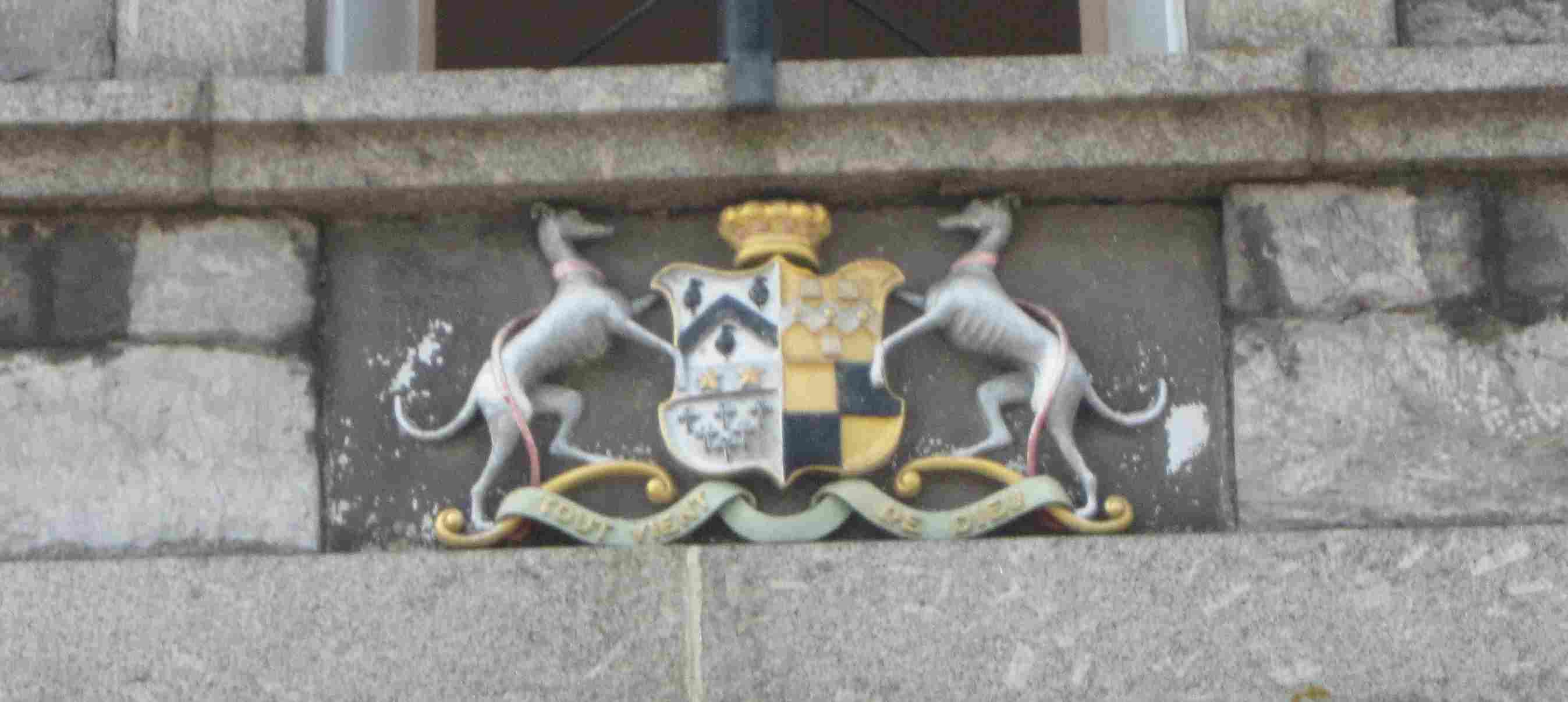
Above: The Clinton Arms, outside the Town Hall
My own photograph
Both the 19th and the 20th Lord Clinton are particularly associated with Ashburton:
Charles Rodolph Trefusis, 19th Lord Clinton
He was born 9 November 1791, and died 10 April 1866
http://thepeerage.com Person p 1227 Accessed 30-9-2013
And Charles Henry Rolle Hepburn-Stuart-Forbes-Trefusis, 20th Lord Clinton.
He was born 2 March 1834, and died 29 March 1904
(The 19th) Lord Clinton paid for a new Market Hall in North Street. Preparations were underway in 1846, when the Western Times said that the market belonged to Lord Clinton, and that he was Lord of the manor.
The foundation stone of the tower was laid in February 1850
Western Times 2 March 1850 p6 col6
Western Times 23 May 1846 p5 col4
For more on the Town Hall, see the Markets and fairs sub-section of Gathering together.
*******
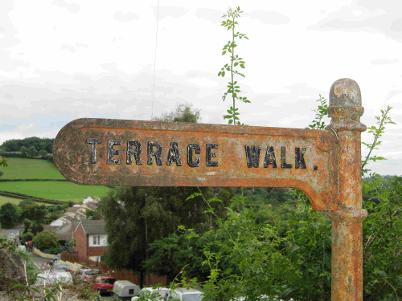
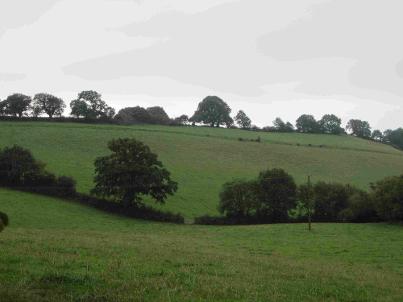
Above: Signpost to the Terrace Walk, Roborough end
Above right: The Walk
My own photographs 2013 and 2014
* The Terrace *
He is also credited with creating the Terrace Walk, which can be accessed from near the top of North Street or from the edge of Higher Roborough.
'The promenade called Clinton Terrace was made a few years ago by Lord Clinton...'
History, gazetteer and directory of Devonshire, William White, 1850, p 463. Available for free as a Google eBook.
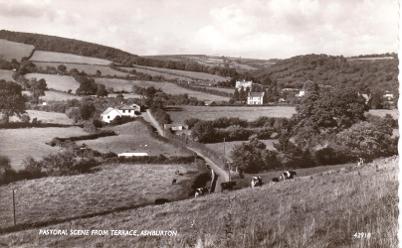
Above: View from the Terrace Walk
From my own collection
This seems to be confirmed by the following news item which also calls the walk Clinton Terrace:
1856 the Western Times spoke of the fine views to be had from Clinton Terrace on the north side of the town.
It said that it could be improved by a few seats along its length.
Western Times 19 July 1856 p7 col3
White's History, Gazetteer and Directory of Devon 1878-79, p105
Lord Clinton died in Cairo in 1904. He was buried in St James' churchyard, Huish, and there was a memorial service at Exeter Cathedral.
In Ashburton muffled peals of bells were rung, and flags were at half mast on St Andrews' tower, the Constitutional Club, and some private houses.
Exeter and Plymouth Gazette 6 May 1904 p11 cols2,3
In 1905 Lord Clinton's estate at Ashburton was sold at the Golden Lion Hotel. Mr E J Sawdye was the auctioneer.
Amongst the 90 lots were the following sales:
The Hon R Dawson bought the Town Hall and market tolls, together with the fish, corn and pannier market for £1,500
Mr E Tucker bought 77 acres for £1050
Mr Field paid £900 for a limestone quarry and fields.
The sale realised about £23,000.
Western Times 28 June 1905 p3 col2
The Amery family has now moved to The Sparke and Amery family, under Individual families.
*******
The varying fortunes of Holne Cross
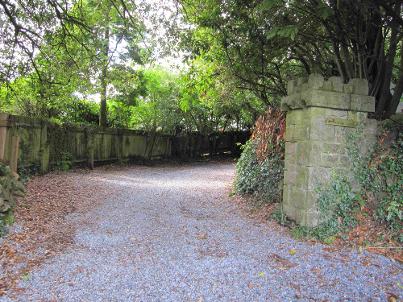
From my own collection.
The 1901 census shows a Henrietta Robinson living with her widowed mother, 84 year old Susanna Robinson, at Selbourne, Ashburton. Henrietta's brother Charles is living in Somerset at the time, but ten years later brother and sister are together at Holne Cross (see below) I do not know where Selbourne is or was, but it is on a different page and folio to both Higher Headboro, and Druid House, the nearest neighbours either side of Holne Cross.
http://www.findmypast.co.uk/
In 1903 a Miss Robinson of Holne Cross Castle distributed prizes in connection with technical classes in Ashburton.
Exeter and Plymouth Gazette 1 May 1903 p13 col6
A large basically square property appears on the Ordnance Survey map of 1905, sheet CV111.15, scale 25 inches to the mile. It is labelled Holne Cross.
In March 1906 C E Robinson C E was appointed one of the members of the Board of Conservators for the Dart Fishery. His address is Holne Cross, Ashburton.
He is appointed every year from then until 1909.
Western Times 23 March 1906 p5 col1
Later that same year a Robinson of Holne
Cross is letting a country house for August and September: it is
described as having four reception rooms, nine bed and dressing rooms,
two bathrooms and a 'photo room'. 13 acres go with the property, which
include gardens and a tennis court.
Exeter and Plymouth Gazette 28 July 1906 p6 col5
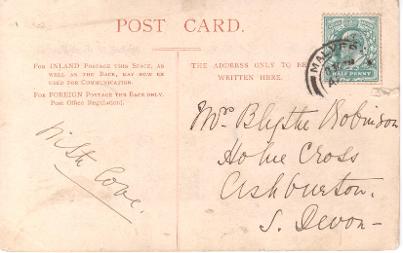
From my own collection
Western Times 29 July 1910 p10 col1
http://www.freebmd.org.uk/
Her son Charles Edward Robinson is at Holne Cross in the 1911 census, living with his sister Henrietta Maria. He is a Civil Engineer, she a Gentlewoman, living on private means.
http://.ancestry.co.uk/
But in the summer of 1912 the house, described as an important residential property, is for sale.
Exeter and Plymouth Gazette 22 June 1912 p1 col4
The following year the members of the South Devon Hunt met in the Globe Hotel, Newton Abbot. Arrangements were being made to give Mr Cooke Hurle a subscription for 'hunting the country'. The Chairman said that by living at Holne Cross Mr Cooke Hurle would be 'in the centre of the county' and well placed to look after hunting in the area.
Shortly afterwards Mr J A C Hurle is one of the judges of horses and ponies at the Paignton Show.
Exeter and Plymouth Gazette 1 May 1913 p5 col6
Western Times 24 July 1913 p2 col5
In November of the same year, when he is described as Master of the Foxhounds, he is summoned by George Crook at the Petty Sessions. The charge is one of assault.
Mr Crook had gone to see Mr Cooke Hurle to ask why his daughter had been dismissed from her job as a servant. Both prosecutor and defendant had different versions of the events that led up to the ensuing physical fight.
The case was dismissed, with each party to pay their own costs.
Western Times 26 November 1913 p3 col5
In April of 1914 the annual judging of South Devon Hunt puppies took place at Holne Cross. Mrs Cooke Hurle distributed the prizes.
Western Times 20 April 1914 p3 col5
1919 Mrs Still of Holne Cross is advertising for a cook. 4 maids are kept, and there will be 'liberal outings'. The wages are £35 to £40*.
The following year Mrs Still is looking for a married couple to employ, one of whom is to be a cook.
Western Times 27 May 1919 p4 col1
Western Times 31 August 1920 p4 col1
* This would be per annum.
Charles John Gundry Still was living at Holne Cross at the time of the 1921 census,
together with his wife, Bertha Jane Muriel. They had four servants, of whom two had been born in Ashburton: 34 year old Charlie Campion (gardener crossed out and servant inserted), and his wife Annie (cook crossed out and servant inserted).
1921 census registration district 272, sub-district 272/4, enumeration district 2
By 1923 it is a Mrs John Godden who is looking for staff: she requires a cook, a parlourmaid, a housemaid, a house-parlourmaid and a kitchenmaid.
Later the same month she is looking for a Naval Pensioner, aged 45-50, to become a butler.
Advertisements for various staff appear until 1938.
Western Morning News 10 February 1923 p10 col2
Western Morning News 23 February 1923 p8 col2
*******
Some people staying or working at Holne Cross:
1926 Albert Bridgman of Holne Cross is fined £2 plus costs for driving a motor vehicle to the danger of the public.
Western Times 1 April 1926 p6 col6
In 1928 Miss Jenner of Holne Cross House was knocked down by a sailor riding a motor cycle
Western Times 23 November 1928 p13 col1
A young man call Maston at Holne Cross is seeking work throughout the beginning of 1931.
A Reginald Harry Maston, second son of Mr and Mrs T Maston, Holne Cross, marries Mollie Bonstow in 1934.
eg Western Morning News 26 June 1931 p2 col3
Western Times 5 January 1934 p13 col2
*******
Mr John Godden died in February 1938, leaving an estate worth £179,475 gross, £135,656 net. Estate duty of £33,012 was paid*. But the validity of his will was being challenged: his sons William Herman Godden of Kent and Ernest Edwin Godden of Leatherhead, both retired mining engineers, had been appointed administrators in the case of Godden v Godden and others.
The will was proved the following January: his wife was left £1000 and an annuity of £2000 per annum, with most of the rest of the estate going to his children, with some of it in trust. He left his chauffeur, Alfred Victor Daymond, £100.
Western Morning News 15 August 1938 p8 col1
Western Morning News 12 January 1939 p8 col2
* Slightly different figures in the second account.
But by this time John Godden's widow, Mrs Augusta J Godden, had also died, the death being registered in the December quarter of 1938.
http://www.freebmd.org.uk/
In May 1939 the property was up for sale. Amongst its selling points was ample spring water, electric light and central heating.
Western Morning News 6 May 1939 p4 col6
Even as the property was being sold, war was looming, and September saw the beginning of the Second World War.
Elfriede Fonfeder, a Hungarian, was summoned under the Aliens Restriction Order for being absent without permission from her residence on two occasions. She gave her address as Holne Cross Hotel, Ashburton.
Western Times 24 December 1941 p2 col5
By January 1941 Holne Cross had become Holne Cross Hostel for evacuee* children, with matron Mrs Jordan.
The children had a special tea and games in January 1941, receiving two gifts and a handkerchief from the Christmas tree.
Western Times 10 January 1941 p2 col3
* The fact that the hostel was for evacuees is confirmed by an advertisement for a cook in November. In the May 1944 news item (below) it is described as an establishment for problem and sick evacuee children, supervised by Devon County Council Medical Department
Western Morning News 28 November 1941 p1 col7
The South West Heritage Centre holds an album of photographs owned by Elizabeth J Dowdeswell. The photographs were taken at two hostels for problem evacuee children - one of the hostels was at Holne Cross, Ashburton. The description says that older boys were sent to Ashburton, but were transferred to Crownwell in 1942. After a fire at Crownwell in 1944 the boys were moved out: girls and younger boys were moved to Crownwell from Ashburton later the same year.
Ref 8062M, South West Heritage Centre, https:/devon-catswheritage.org.uk - accessed 15-01-2025
The Christmas treat for evacuee children in January 1944 included the assistant Matron of Holne Cross Hostel, Miss E Dowdeswell, leading the community singing.
Western Times 7 January 1944 p7 col2
Four months later the hostel was in ruins. A fire, which began in the roof and was discovered on the morning of May 2nd, was tackled by the N F S (National Fire Service), and assistance was given by American soldiers who were in the area. But their efforts were in vain - the fire gutted the property. The children, who numbered about 40 at the time, were at school: no-one was injured.
Western Morning News 3 May 1944 p2 col2
*******